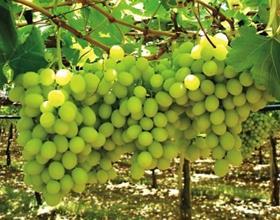
The heat wave currently bringing temperatures in the mid-40s to Australia’s south eastern Sunraysia region has added insult to injury for the already heat-stressed table grape crop, according to growers.
While the heat is beginning to abate, there are concerns lowered fruit quality will hit exports already labouring under a high-flying Australian dollar.
“Mother nature dealt us a bum hand this year, that’s for sure,” David Minnis of 888 Exports told Fruitnet.com. “We’ve had enough heat from November onwards, and the current heat wave doesn’t help.”
National table grape volumes are down around 30 per cent this season from last, said Mr Minnis; a combination of the heat and last year’s bumper crop.
Flame Seedless, Menindee Seedless (Sugraone), Midnight Beauty, Autumn Royal and Thompson Seedless are the varieties reportedly worst affected.
“There’s a lot of undersized fruit; all the early grapes have been undersized,” explained Mr Minnis. “We’re also having a lot of mixed size in bunches, which makes it hard to sell the fruit.
“Crimson Seedless will also be very dark because of the heat, which is a bit of a worry. We’ll have to explain to buyers the Crimson will not be cherry red, it will be black red, and the dark fruit is not preferred in China.”
Mr Minnis said the heat in November had caused significant fruit drop; one of his growers who had originally anticipated marketing 35,000 trays of Menindee Seedless had ended up with only 5,000 trays of market-quality fruit.
He said the Flame Seedless were also experiencing small berry size around 14-18mm.
Growers have also raised concerns about the Thompson Seedless variety, which could repeat disastrous reactions to high temperatures.
“There seems to be concern about the outcome of Thompson Seedless,” one Mildura-based grower told Fruitnet.com. “In previous years they’ve had berry collapse from heat, and there’s a concern it might happen again.'
The grower also stated Red Globe grapes had been hit with sunburn problems on 16-17 December last year, and the variety has also suffered from mixed bunch sizing.
“The heat has affected not so much the volumes as the quality.”
Concerns about the Thompson crop reach back to November, when growers skipped the application of gibberellic acid, a sizing agent, amid dehydration concerns.
“If we put gibberellic acid (GA) on and there’s heat, like in November, there’ll be problems,” explained Mr Minnis.
“The process is basically stretching the skin, so if there’s heat you get dehydration and berry collapse. We didn’t put on the GA this season because of that, so we’ve got differently shaped berries; they’re oval, not long and skinny.”
One market that could have relieved the pressure on exporters is Indonesia, but unfortunately new chemical residue entry requirements have ruled the market out.
Indonesia traditionally takes smaller sized grapes than most Asian markets, but the new requirements dictating every shipment must have chemical residue test certificates, which adds significant delay and uncertainly to the trade, according to Mr Minnis.
“I believe at the moment there are no grapes going to Indonesia, but it’s traditionally our third largest market,” he said.
“We have to find laboratories for testing that can do the right standard, and I believe it could take around 10 days for a result, which really eliminates airfreight.”
“Indonesian officials visited Australia in the second week of December to look at the way we handle MRLs `maximum residue levels`.
“We’re hoping they give us approved country status so we don’t have to have to do shipment-by-shipment testing. So far I think they’ve only given that status to Thailand and the US.”






No comments yet